In This Topic
Step 1: Check your data for problems
Important
For a more thorough analysis of these requirements, use Between/Within Capability Sixpack.
Visually examine the distribution of the data
Compare the solid overall curve to the bars of the histogram to assess whether your data are approximately normal. If the bars vary greatly from the curve, your data may not be normal and the capability estimates may not be reliable for your process. If your data appear to be nonnormal, use Individual Distribution Identification to determine whether you need to transform the data or fit a nonnormal distribution to perform capability analysis.
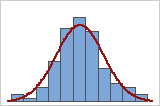
Good fit
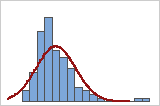
Poor fit
Note
You can use the Box-Cox option in Between/Within Capability Analysis to transform nonnormal data. To fit a nonnormal distribution to your data, use Nonnormal Capability Analysis.
Compare the between/within and overall curves
Compare the solid overall curve and the dashed between/within curve to see how closely they are aligned. A substantial difference between the B/W curve and the overall curve may indicate that the process is not stable, or that your process has other sources of variation in addition to the variation between/within subgroups.Use a control chart to verify that your process is stable before you perform a capability analysis.
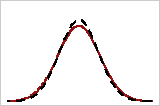
Closely aligned
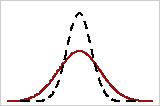
Poorly aligned
Step 2: Examine the observed performance of your process
Use the capability histogram to visually examine the sample observations in relation to the process requirements.
Examine the process spread
Visually examine the data in the histogram in relation to the lower and upper specification limits. Ideally, the spread of the data is narrower than the specification spread, and all the data are inside the specification limits. Data that are outside the specification limits represent nonconforming items.
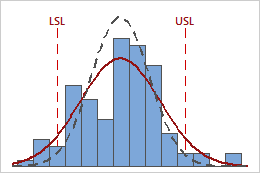
In this histogram, the process spread is wider than the specification spread, which suggests poor capability. Although most of the data are within the specification limits, there are nonconforming items below the lower specification limit (LSL) and above the upper specification limit (USL).
Note
To determine the actual number of nonconforming items in your process, use the results for PPM < LSL, PPM > USL, and PPM Total. For more information, go to All statistics and graphs.
Assess the center of the process
Evaluate whether the process is centered between the specification limits or at the target value, if you have one. The center of the data occurs at the peak of the distribution curve and is estimated by the sample mean.
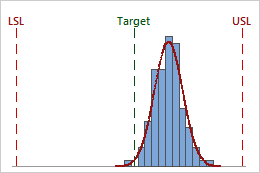
In this histogram, although the sample observations fall inside of the specification limits, the peak of the distribution curve is not centered on the target. Most of the data exceed the target value.
Step 3: Evaluate the capability of the process
Use the main capability indices to evaluate how well your process meets requirements.
Assess between/within capability
Use Cpk to evaluate the between/within capability of your process considering both its location and spread. In general, higher Cpk values indicate a more capable process while lower Cpk values indicate that the process may need improvement.
-
Compare Cpk with a benchmark that represents the minimum value that is acceptable for your process. Many industries use a benchmark value of 1.33. If Cpk is lower than your benchmark, consider ways to improve your process, such as reducing its variation or shifting its location.
-
Compare Cp and Cpk. If Cp and Cpk are approximately equal, then the process is centered between the specification limits. If Cp and Cpk differ, then the process is not centered.
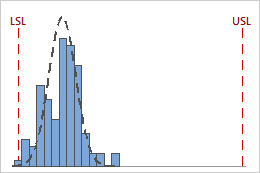
Key Result: Cpk
For these process data, Cpk is 1.09. Because Cpk less than 1.33, the between/within capability of the process does not meet customer requirements. The process is running too close to the lower specification limit. The process is not centered, so Cpk does not equal Cp (2.76).
Assess overall capability
Use Ppk to evaluate the overall capability of your process based on both the process location and the process spread. Overall capability indicates the actual performance of your process that your customer experiences over time.
Generally, higher Ppk values indicate a more capable process. Lower Ppk values indicate that your process may need improvement.
-
Compare Ppk to a benchmark value that represents the minimum value that is acceptable for your process. Many industries use a benchmark value of 1.33. If Ppk is lower than your benchmark, consider ways to improve your process.
-
Compare Pp and Ppk. If Pp and Ppk are approximately equal, then the process is centered between the specification limits. If Pp and Ppk differ, then the process is not centered.
- Compare Cpk and Ppk. If Cpk is considerably greater than Ppk, there may be other sources of systemic variation in the process, in addition to the variation between and within the subgroups. For example, tool wear is a systemic source of variation that could cause a manufacturing process to exhibit greater between/within capability (Cpk) than overall capability (Ppk).

Key Result: Ppk
For these process data, Ppk = 0.52. Because Ppk is less than 1.33, the overall capability of the process does not meet customer requirements. The process is centered, so Ppk ≈ Pp (0.53). However, Ppk < Cpk (0.72), which indicates that the overall capability could be improved if additional sources of systemic process variation were reduced or eliminated.
Important
The Cpk and Ppk indices measure the capability of the process in relation only to the specification limit that is closest to the process mean. Therefore, these indices represent only one side of the process curve, and do not measure how the process performs on the other side of the process curve. If your process produces nonconforming items that fall outside both the lower and upper specification limits, use additional capability measures in the output to more fully assess process performance. For more information, go to All statistics and graphs.
